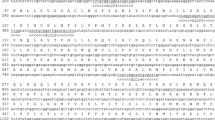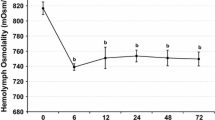Abstract
The estuarine tapertail anchovy Coilia nasus is a widely distributed and commercially important aquaculture species. It responds strongly to stresses, such as netting, loading, and transport, which inevitably always induces tissue injury or even death. The glyoxalase 1 gene (Glo1) is very important in many physiological processes and diseases. To understand how transport induces changes in Glo1 expression, we cloned the C. nasus Glo1 gene (CnGlo1). Its full-length cDNA is 1033 bp, with a 549-bp open reading frame, which encodes a 182-amino acid protein. CnGlo1 is predicted to contain a typical glyoxalase domain (amino acids 26–169). CnGlo1 mRNA is expressed ubiquitously, but more strongly in the brain, liver, heart, head kidney, and gill than in the kidney, intestine, muscle, and spleen. Results of the reverse transcription–quantitative PCR analysis of the tissues of stressed fish revealed a 2.5- to 16.1-fold increase in CnGlo1 expression in the liver and a 2.0- to 4.8-fold increase in the brain. Protein expression was determined with western blotting, and the expression pattern was similar to that of the mRNA. Here, we report the molecular cloning, sequencing, and differential expression of the CnGlo1 gene and the effects of stress on CnGlo1 expression.







Similar content being viewed by others
References
Gale CP, Grant PJ (2004) The characterisation and functional analysis of the human glyoxalase-1 gene using methods of bioinformatics. Gene 340:251–260
Rabbani N, Thornalley PJ (2011) Glyoxalase in diabetes, obesity and related disorders. Semin Cell Dev Biol 22:309–317
Urscher M, Alisch R, Deponte M (2011) The glyoxalase system of malaria parasites—implications for cell biology and general glyoxalase research. Semin Cell Dev Biol 22:262–270
Chakraborty S, Gogoi M, Chakravortty D (2015) Lactoylglutathione lyase, a critical enzyme in methylglyoxal detoxification, contributes to survival of Salmonella in the nutrient rich environment. Virulence 6:50–65
Chocholaty M, Jachymova M, Schmidt M, Havlova K, Krepelova A, Zima T, Babjuk M, Kalousova M (2015) Polymorphisms of the receptor for advanced glycation end-products and glyoxalase I in patients with renal cancer. Tumour Biol 36:2121–2126
Chen F, Wollmer MA, Hoerndli F, Munch G, Kuhla B, Rogaev EI, Tsolaki M, Papassotiropoulos A, Gotz J (2004) Role for glyoxalase I in Alzheimer’s disease. Proc Natl Acad Sci USA 101:7687–7692
Hambsch B (2011) Altered glyoxalase 1 expression in psychiatric disorders: cause or consequence? Semin Cell Dev Biol 22:302–308
Hovatta I, Tennant RS, Helton R, Marr RA, Singer O, Redwine JM, Ellison JA, Schadt EE, Verma IM, Lockhart DJ, Barlow C (2005) Glyoxalase 1 and glutathione reductase 1 regulate anxiety in mice. Nature 438:662–666
Kuhla B, Boeck K, Luth HJ, Schmidt A, Weigle B, Schmitz M, Ogunlade V, Munch G, Arendt T (2006) Age-dependent changes of glyoxalase I expression in human brain. Neurobiol Aging 27:815–822
Kuhla B, Boeck K, Schmidt A, Ogunlade V, Arendt T, Munch G, Luth HJ (2007) Age- and stage-dependent glyoxalase I expression and its activity in normal and Alzheimer’s disease brains. Neurobiol Aging 28:29–41
Distler MG, Plant LD, Sokoloff G, Hawk AJ, Aneas I, Wuenschell GE, Termini J, Meredith SC, Nobrega MA, Palmer AA (2012) Glyoxalase 1 increases anxiety by reducing GABAA receptor agonist methylglyoxal. J Clin Invest 122:2306–2315
Lin CC, Yin MC (2008) Antiglycative and anti-VEGF effects of S-ethyl cysteine and S-propyl cysteine in kidney of diabetic mice. Mol Nutr Food Res 52:1358–1364
Santel T, Pflug G, Hemdan NY, Schäfer A, Hollenbach M, Buchold M, Hintersdorf A, Lindner I, Otto A, Bigl M, Oerlecke I, Hutschenreuter A, Sack U, Huse K, Groth M, Birkemeyer C, Schellenberger W, Gebhardt R, Platzer M, Weiss T, Vijayalakshmi MA, Krüger M, Birkenmeier G (2008) Curcumin inhibits glyoxalase 1—a possible link to its anti-inflammatory and anti-tumor activity. PLoS One 3:e3508
Kim KM, Kim YS, Jung DH, Lee J, Kim JS (2012) Increased glyoxalase I levels inhibit accumulation of oxidative stress and an advanced glycation end product in mouse mesangial cells cultured in high glucose. Exp Cell Res 318:152–159
Liu L, Xu Y, Xu L, Wang J, Wu W, Xu L, Yan Y (2015) Analysis of differentially expressed proteins in zebrafish (Danio rerio) embryos exposed to chlorpyrifos. Comp Biochem Phys C 167:183–189
Andreassen R, Lunner S, Hoyheim B (2009) Characterization of full-length sequenced cDNA inserts (FLIcs) from Atlantic salmon (Salmo salar). BMC Genom 10:502
Elia AC, Fanetti A, Dorr AJ, Taticchi MI (2008) Effects of concentrated drinking water injection on glutathione and glutathione-dependent enzymes in liver of Cyprinus carpio L. Chemosphere 72:791–796
Jorgens K, Stoll SJ, Pohl J, Fleming TH, Sticht C, Nawroth PP, Hammes HP, Kroll J (2015) High tissue glucose alters intersomitic blood vessels in zebrafish via methylglyoxal targeting the VEGF receptor signaling cascade. Diabetes 64:213–225
Antognelli C, Romani R, Baldracchini F, De Santis A, Andreani G, Talesa V (2003) Different activity of glyoxalase system enzymes in specimens of Sparus auratus exposed to sublethal copper concentrations. Chem Biol Interact 142:297–305
Regoli F, Pellegrini D, Winston GW, Gorbi S, Giuliani S, Virno-Lamberti C, Bompadre S (2002) Application of biomarkers for assessing the biological impact of dredged materials in the Mediterranean: the relationship between antioxidant responses and susceptibility to oxidative stress in the red mullet (Mullus barbatus). Mar Pollut Bull 44:912–922
Jiang T, Yang J, Liu H, Shen XQ (2012) Life history of Coilia nasus from the Yellow Sea inferred from otolith Sr:Ca ratios. Environ Biol Fish 95:503–508
Du F, Xu G, Nie Z, Xu P, Gu R (2014) Transcriptome analysis gene expression in the liver of Coilia nasus during the stress response. BMC Genom 15:558
Du F, Xu G, Nie Z, Xu P, Gu R (2014) Molecular characterization and differential expression of the myostatin gene in Coilia nasus. Gene 543:153–160
Ariza A, Vickers TJ, Greig N, Fairlamb AH, Bond CS (2005) Crystallization and preliminary X-ray analysis of Leishmania major glyoxalase I. Acta Crystallogr Sect F Struct Biol Cryst Commun 61:769–772
Espartero J, Sanchez I, Pardo JM (1995) Molecular characterization of glyoxalase-I from a higher plant; upregulation by stress. Plant Mol Biol 29:1223–1233
Inoue Y, Maeta K, Nomura W (2011) Glyoxalase system in yeasts: structure, function, and physiology. Semin Cell Dev Biol 22:278–284
Kim NS, Umezawa Y, Ohmura S, Kato S (1993) Human glyoxalase I cDNA cloning, expression, and sequence similarity to glyoxalase I from Pseudomonas putida. J Biol Chem 268:11217–11221
Lu T, Creighton DJ, Antoine M, Fenselau C, Lovett PS (1994) The gene encoding glyoxalase I from Pseudomonas putida: cloning, overexpression, and sequence comparisons with human glyoxalase I. Gene 150:93–96
McMurray KM, Distler MG, Sidhu PS, Cook JM, Arnold LA, Palmer AA, Plant LD (2014) Glo1 inhibitors for neuropsychiatric and anti-epileptic drug development. Biochem Soc T 42:461–467
Wu S, Zhang X, He Y, Shuai J, Chen X, Ling E (2010) Expression of antimicrobial peptide genes in Bombyx mori gut modulated by oral bacterial infection and development. Dev Comp Immunol 34:1191–1198
Xue M, Rabbani N, Thornalley PJ (2011) Glyoxalase in ageing. Semin Cell Dev Biol 22:293–301
Thornalley PJ (1993) The glyoxalase system in health and disease. Mol Aspects Med 14:287–371
Thornalley PJ (2003) Glyoxalase I–structure, function and a critical role in the enzymatic defence against glycation. Biochem Soc T 31:1343–1348
Ridderstrom M, Mannervik B (1996) The primary structure of monomeric yeast glyoxalase I indicates a gene duplication resulting in two similar segments homologous with the subunit of dimeric human glyoxalase I. Biochem J 316(Pt 3):1005–1006
Cameron AD, Olin B, Ridderstrom M, Mannervik B, Jones TA (1997) Crystal structure of human glyoxalase I—evidence for gene duplication and 3D domain swapping. EMBO J 16:3386–3395
Cameron AD, Ridderstrom M, Olin B, Kavarana MJ, Creighton DJ, Mannervik B (1999) Reaction mechanism of glyoxalase I explored by an X-ray crystallographic analysis of the human enzyme in complex with a transition state analogue. Biochemistry 38:13480–13490
Clelland JD, Thornalley PJ (1991) S-2-hydroxyacylglutathione-derivatives: enzymatic preparation, purification and characterisation. J Chem Soc Perk T 1:3009–3015
Himo F, Siegbahn PE (2001) Catalytic mechanism of glyoxalase I: a theoretical study. J Am Chem Soc 123:10280–10289
Inoue Y, Tsujimoto Y, Kimura A (1998) Expression of the glyoxalase I gene of Saccharomyces cerevisiae is regulated by high osmolarity glycerol mitogen-activated protein kinase pathway in osmotic stress response. J Biol Chem 273:2977–2983
Nishikawa T, Edelstein D, Du XL, Yamagishi S, Matsumura T, Kaneda Y, Yorek MA, Beebe D, Oates PJ, Hammes HP, Giardino I, Brownlee M (2000) Normalizing mitochondrial superoxide production blocks three pathways of hyperglycaemic damage. Nature 404:787–790
Beisswenger PJ, Howell SK, Nelson RG, Mauer M, Szwergold BS (2003) Alpha-oxoaldehyde metabolism and diabetic complications. Biochem Soc T 31:1358–1363
Brownlee M, Cerami A, Vlassara H (1988) Advanced glycosylation end products in tissue and the biochemical basis of diabetic complications. N Engl J Med 318:1315–1321
Rabbani N, Thornalley P (2012) Methylglyoxal, glyoxalase 1 and the dicarbonyl proteome. Amino Acids 42:1133–1142
Thornalley PJ (1996) Pharmacology of methylglyoxal: formation, modification of proteins and nucleic acids, and enzymatic detoxification—a role in pathogenesis and antiproliferative chemotherapy. Gen Pharmacol 27:565–573
AluruN Vijayan MM (2008) Molecular characterization, tissue-specific expression, and regulation of melanocortin 2 receptor in rainbow trout. Endocrinology 149:4577–4588
Aluru N, Vijayan MM (2009) Stress transcriptomics in fish: a role for genomic cortisol signaling. Gen Comp Endocr 164:142–150
Morcos M, Du X, Pfisterer F, Hutter H, Sayed AA, Thornalley P, Ahmed N, Baynes J, Thorpe S, Kukudov G, Schlotterer A, Bozorgmehr F, ElBaki RA, Stern D, Moehrlen F, Ibrahim Y, Oikonomou D, Hamann A, Becker C, Zeier M, Schwenger V, Miftari N, Humpert P, Hammes HP, Buechler M, Bierhaus A, Brownlee M, Nawroth PP (2008) Glyoxalase-1 prevents mitochondrial protein modification and enhances lifespan in Caenorhabditis elegans. Aging Cell 7:260–269
Acknowledgments
This study was supported by the Special Fund of the Chinese Central Government for Basic Scientific Research Operations in Commonwealth Research Institutes (Grant No. 2015JBFR06), The National Science Foundation for Young Scientists of China (Grant No. 31502152), the Natural Science Foundation of Jiangsu Province, China (Grant No. BK20140121), the Key Technology R&D Program of Jiangsu Province (Grant No. BE2014307), and the Three New Projects of Agricultural Aquaculture Program of Jiangsu Province (Grant No. D2015-14).
Author information
Authors and Affiliations
Corresponding author
Rights and permissions
About this article
Cite this article
Du, F., Xu, G., Li, Y. et al. Glyoxalase 1 gene of Coilia nasus: molecular characterization and differential expression during transport stress. Fish Sci 82, 719–728 (2016). https://doi.org/10.1007/s12562-016-1003-y
Received:
Accepted:
Published:
Issue Date:
DOI: https://doi.org/10.1007/s12562-016-1003-y




